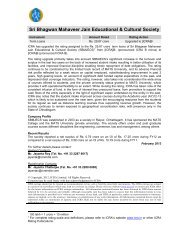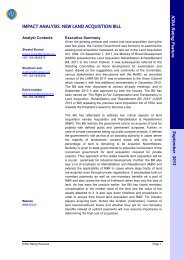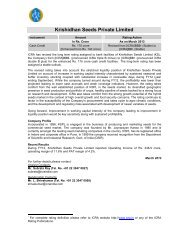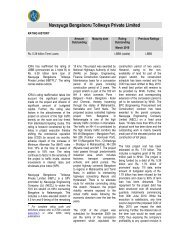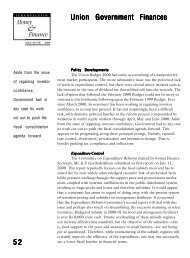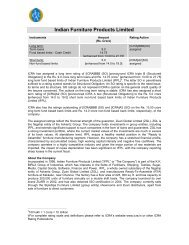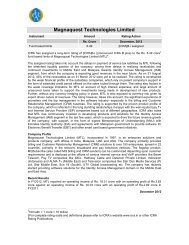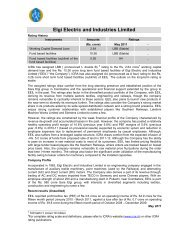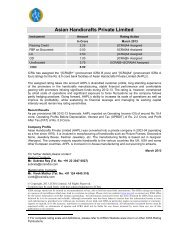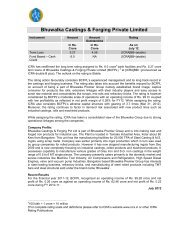Create successful ePaper yourself
Turn your PDF publications into a flip-book with our unique Google optimized e-Paper software.
Jul-10<br />
Aug-10<br />
Sep-10<br />
Oct-10<br />
Nov-10<br />
Dec-10<br />
Jan-11<br />
Feb-11<br />
Mar-11<br />
Apr-11<br />
May-11<br />
Jun-11<br />
Jul-11<br />
Aug-11<br />
Sep-11<br />
Oct-11<br />
Nov-11<br />
Dec-11<br />
<strong>ICRA</strong> Equity Research Service<br />
<strong>Kewal</strong> <strong>Kiran</strong> <strong>Clothing</strong> <strong>Limited</strong><br />
Profitability indicators remain vulnerable to cotton price fluctuations; volume/margin pressures likely to ease<br />
from Q4, FY12 onwards when the decline in cotton prices will reflect for the garment retail industry<br />
KKCL, being a leading garments manufacturer, remains<br />
vulnerable to steep fluctuations in cotton prices. Raw cotton<br />
Domestic Cotton Prices (Sankar 6;<br />
prices for the Sankar-6 variety had increased from ~30,000<br />
Rs/Candy)<br />
Rs/candy (1 candy = 355 kg) in July 2010 to ~62,000 70,000<br />
Rs/candy (1 candy = 355 kg) in March 2011 on account of 60,000<br />
demand revival in developed economies and production 50,000<br />
disruptions due to adverse agro-climatic conditions in China<br />
40,000<br />
and Pakistan. The steep rise in cotton prices had resulted in<br />
30,000<br />
high cost inventories and hence constrained volume growth<br />
20,000<br />
as well as operating margins across the value chain until the<br />
10,000<br />
Q3, FY12. However, the raw cotton prices have corrected<br />
0<br />
significantly over the last 6-8 months to ~35,000 Rs/candy<br />
in Dec 2011 on account of deterioration in global demand<br />
outlook and healthy productions estimates for the 2011-12<br />
cotton season globally.<br />
Source: EmergingTextiles.com; <strong>ICRA</strong> Equity Research Service<br />
Raw material costs accounts for a higher proportion of the<br />
Denim fabric costs due to higher cotton yarn usage than trouser/shirting fabrics. As a result, the denim fabric prices<br />
had risen by approximately 30-40% in the past one year while shirting fabric prices had risen by 20-25% in the same<br />
period. Faced with the twin challenge of rising input costs and excise duty hike, most players had increased their<br />
prices with KKCL increasing it by about 10-12%. Since the production cycle for branded apparel manufacturers<br />
function with a lag of about eight-nine months, the pricier garments produced from high cost fabric inventory will<br />
remain in the retail stores until Q3, FY12. This has led to some volume pressure as witnessed in slowdown in same<br />
store sales during the current season as well as margin pressure as the raw material cost increases could not be<br />
passed on completely. The lower cotton costs will start reflecting for branded apparel industry only from Q4 FY12<br />
onwards, easing pressure on the volumes as well as operating margins of the players across the value chain.<br />
Regulatory changes a risk factor..<br />
The company also remains vulnerable to regulatory changes like the 10% excise duty levied on all branded apparel<br />
during the last union budget, leading to a cascading effect across the value chain. After a representation from the<br />
industry participants, the government agreed to a partial rollback, imposing the duty on 45% as against the earlier<br />
60% of the MRP. The excise duty hike complicated matters at the time when the industry was already grappling with<br />
severe cost inflation and higher raw material (cotton, polyester, etc) prices. Besides, the organized retail industry in<br />
India continues to suffer due to stringent labour laws, multiple licences and clearances (40-45 approvals) required for<br />
setting up and operating a retail stores, high stamp duties on property deals and exceptionally high property prices<br />
and lease rentals in cities due to urban land ceiling act and delays in new project approvals. Although the proposed<br />
goods and services tax (GST) is expected to reduce complexities in doing business and allowing foreign direct<br />
investments (FDI) in multi-brand retail is expected to improve efficiencies across the supply chain and give a boost to<br />
KKCL’s MBO & national chain store sales, the timelines for their implementation continue to remain uncertain.<br />
Free Trade Agreement with Bangladesh likely to result in cost efficiencies for the branded apparel companies<br />
KKCL’s strategy towards outsourcing is expected to receive a thrust after the recent Free Trade Agreement signed<br />
with Bangladesh. Earlier, there was a cap on import of garments from Bangladesh at 10 million pieces, which is now<br />
removed with effect from September, 2011. Though the Bangladeshi garment sector lacks a raw material base, it has<br />
12



